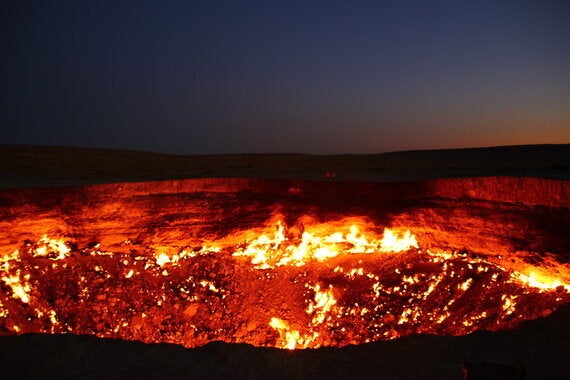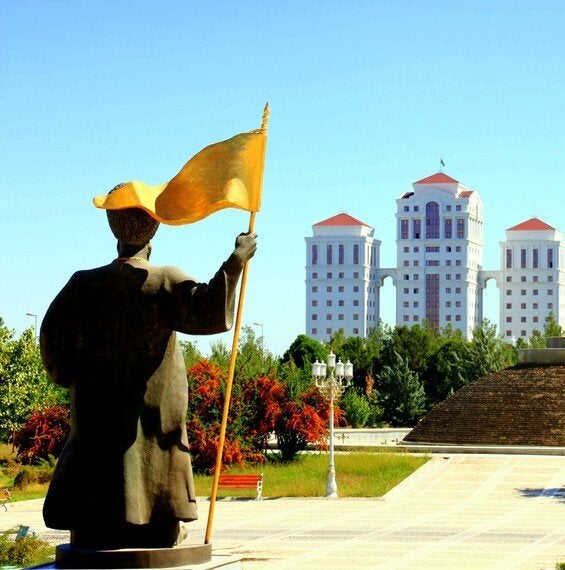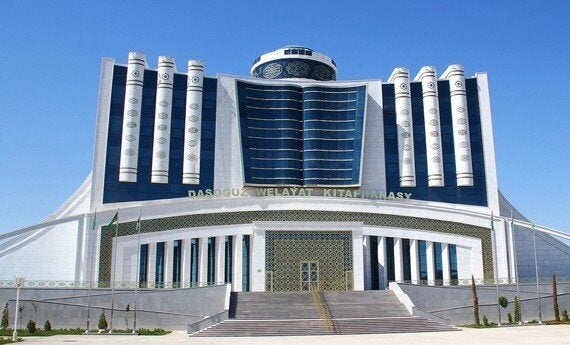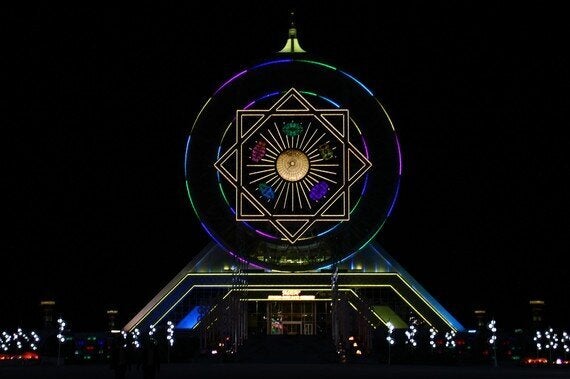
Standing at the edge of a crater the size of an American football field that is leaking flaming gas, my old nemesis of vertigo was making himself known. Or was it just the smell of the methane fumes? I was standing alone at the edge of the Darvaza Gas Crater, central Turkmenistan, which is also known as the 'Door to Hell' - a very fitting accolade.
It was the middle of the night and there was no other light, except for the flames below, and there were only a couple of other tourists standing on the other side of the crater. I nervously tiptoed closer to the glowing abyss - a hard wind hit me full in the face. The shock of the heat was as asphyxiating as entering freezing water, I could barely breathe and could feel it scorching the entire front of my body. I shielded my face with my hands and arms, an action I found myself repeating every few minutes as the wind whipped around.
The Darvaza Crater is a natural gas field which Russian geologists set alight in 1971 while mining in the area to stop it leaking methane, when Turkmenistan was still part of the Soviet Union. The gas was expected to burn itself out in a few days, but forty five years later there are no signs of it abating. The massive amount of thermal energy it gives off creates strong localised gusts of gassy sand-filled wind.
The crater is a 'popular' attraction in a country with very little tourism and a dictatorial regime akin to North Korea - it is ranked as the world's sixth most oppressive regime. Despite this, it remains a safe country to travel to as long as you consent to the rules (hire a 'guide' and pay the obligatory road tax, fuel tax and several other surprise taxes). If you do, the reward is access to a country which is genuinely unlike any other, gaining insight into its bizarre otherworldliness.

The anthropologist you never knew you were will come raging to the surface, with a desperate need to understand Turkmenistan; why is there an eight pointed star everywhere, who on earth was the architect of the peculiar state buildings, why are all the young girls dressed like they are from mediaeval France, and why won't your guide comfortably answer any of these questions indoors or near any electronic devices? Indeed, this is a country where you might question if George Orwell or even H. G. Wells were held in the same regard as Russia did Marx, or if, in fact, you imagined the whole thing.
The capital city, Ashgabat, is a mere 40 kilometres from the Iranian border. I was told in hushed tones by the guide that Turkmenistan did not like Iran as it cheated them on natural gas prices twenty five years ago. Religious radio programmes are still beamed into Ashgabat by the Iranians though, in the hope of reminding the 93% of Muslims in secular Turkmenistan of their powerful neighbour.
The city is built entirely of white marble and gold leaf, and its wide roads are lined with empty detached apartment blocks, hotels and government ministries. Every roundabout and square has marble statues and monuments dedicated to the former dictator, Turkmenbashi, and his 'democratically elected' replacement. The external design of buildings are representative of their function; the Ministry for the Press, for example, had a fifty foot marble open book as its façade, oh the irony. An analogy for the ridiculously exaggerated architecture is difficult to come by, but I imagine it resembles what Dark Age European kings from would have come up with if they had access to the building materials of today - without any update in taste.
The guide proudly told me that the city has a population of over one million, roughly a fifth of the country's total populace. In spite of this, Ashgabat felt eerily abandoned - there was simply no one there. Saying that the city was an immaculate ghost town doesn't quite do the feeling of being watched while alone justice. I asked where everyone was, as it was a Tuesday. 'A national holiday' I was told. I questioned why people where not out in the streets, restaurants and parks then. 'We sit at home and watch TV' came the terse reply. The guide's tone made it clear that they were unable to answer further and I didn't press it.

Millions, if not billions of dollars had clearly been spent on building ministry, hotel and apartment block after ministry, hotel and apartment block - but to seemingly no end or benefit for the population. Very few foreign dignitaries make it out here and there are only around 7,000 tourists a year nationally, making it one of the least visited countries in the world, so who was there to impress?
But impressive it was.
Turkmenistan is fascinating and disturbing in equal measure and is the place to go if you want somewhere that will challenge your understanding of how society works, or perhaps should work. There are only two standalone English language travel guides, and the fact that Lonely Planet isn't one of them is a testament to the unique and insular nature of the state. However, this is its very appeal.
The capital proudly takes another unexpected twist at night, as Ashgabat suddenly looks like a cross between (a deserted) Disneyland and Las Vegas. Each of its distinct buildings is lit up in bright, constantly changing LED lights. This makes a second tour of the city entirely necessary and is a pleasant escape from the oppressive heat of the day.

The heat of the gas crater, however, there was no escape from. I realised that it was the smell of the noxious fumes that caused my queasiness, as holding my breath while still staring down, I quickly felt better. At the bottom of the pit was rocky, with two giant pillars of flame coming up from the floor, surrounded by hundreds of smaller blazes covering the sloping sides and rocky ground. It let off a city's worth of light and the glow could be seen from several miles away, though because it was from one point at ground level, it looked like a giant torch was shining upwards, just below the Earth's surface.
The guide casually mentioned that quite a few drunken tourists had gotten too close to the edge and toppled in. Scanning around for charred remains, I was able to convince myself that this was just scare-mongering to prevent me from getting too close - after all, there were no barriers up. Unsurprisingly, health and safety has not yet reached the Karakum desert, though the adrenaline this causes only adds to the electrifying spectacle.
A sight certainly worth singeing your eyebrows for.

Extras
I traveled to Central Asia with Oasis Overland, an overlanding travel company that I would thoroughly recommend as every aspect of the trip was fantastic (they haven't paid me to say that but if they are reading this and would like to, that's fine).
You can fly from London to Ashgabat via Istanbul with Turkish Airlines for around £300 return.
You will need a letter of introduction and a visa before you travel, which will take some organisation and time, so if you are travelling independently consider seeking advice from a travel visa company to help with this.
All photos are author's own.
---
Emma Rosen taking a radical sabbatical and trying 25 careers before turning 25, travel writing is just one.
View her website and blog here: www.25before25.co.uk